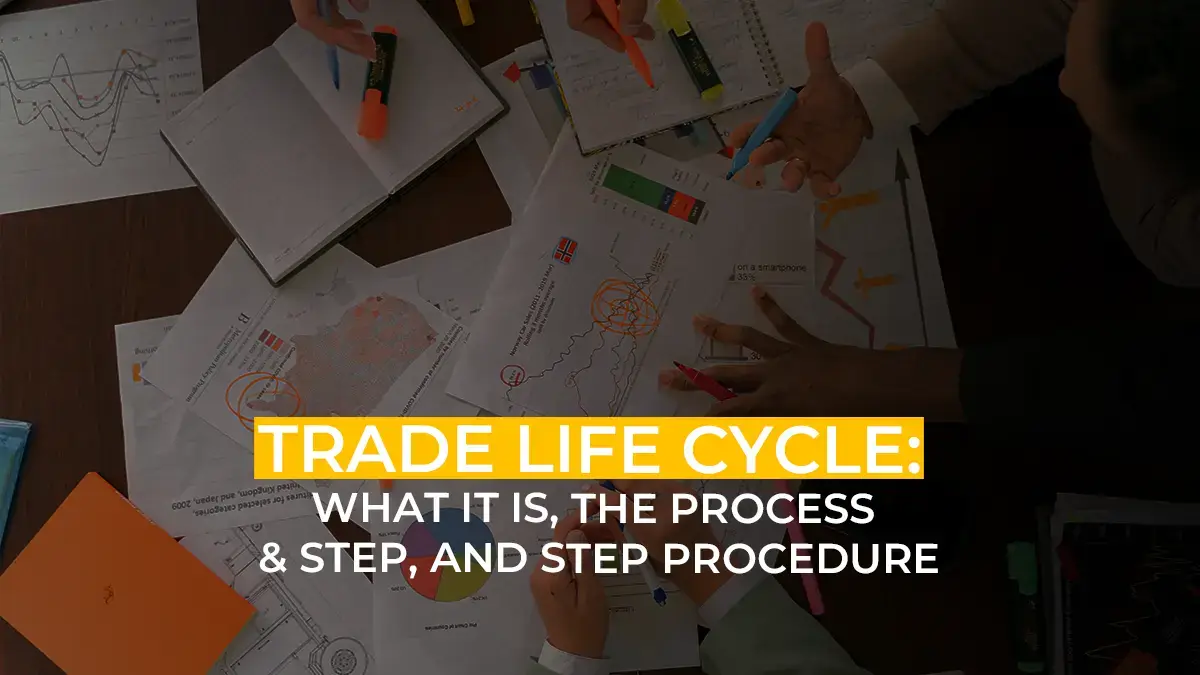Trade Life Cycle: What It Is, The Process & Step, and Step Procedure

Here's What We've Covered!
The trade life cycle is crucial in investment banking. It ensures the smooth handling of financial transactions from start to finish. This process enhances regulatory compliance, reduces risks, and improves operational efficiency.
Efficient trade life cycle methods help in accurate and timely processing of deals, minimizing errors and optimizing resource use. It also promotes transparency and builds trust with regulatory bodies and market participants.
Overall, a well-managed trade life cycle is essential for maintaining financial market stability, supporting informed decision-making, and safeguarding the interests of institutions and investors alike.
What is the Trade Life Cycle?
The trade life cycle in investment banking refers to the step-by-step process of a financial transaction from start to finish. It includes phases like initiation, implementation, verification, resolution, exoneration, reconciliation, and archiving. Each phase involves specific procedures, stakeholders, and systems to ensure a smooth and accurate progression of trades in the financial markets.
Importance of trade life cycle in ensuring smooth implementation and handling of financial deals
The trade life cycle in investment banking is essential, providing the backbone for key financial functions through its structured phases and operations.
- Operational Efficiency: It enhances operational efficiency by streamlining processes and reducing manual errors. This efficiency is crucial for investment banks handling a large volume of daily transactions.
- Risk Mitigation: The trade life cycle plays a vital role in managing various risks such as market, operational, and credit risks. Through thorough processes, it identifies, evaluates, and mitigates these risks, ensuring financial stability and safeguarding the interests of clients and the institution.
- Regulatory Compliance: Investment banks operate in a highly regulated environment. A robust trade life cycle ensures compliance with reporting requirements and financial regulations. This not only helps in avoiding regulatory penalties but also promotes overall transparency and integrity in financial markets.
- Timely Settlement: The resolution stage of the trade life cycle is critical for the prompt settlement of funds and securities. A well-implemented trade life cycle reduces settlement risks, ensuring that transactions are executed swiftly and accurately. This is essential for maintaining market liquidity and minimizing disruptions.
- Transparency and Trust: Effective management of the trade life cycle enhances transparency in financial transactions. Clear and accountable processes build trust among regulatory authorities, market participants, and investors, fostering a more stable and healthier financial environment.
- Strategic Decision-Making: Investment banks rely on timely and accurate information for strategic decision-making. A structured trade life cycle provides immediate insights and data, enabling institutions to make informed decisions regarding portfolio management and investment strategies.
The trade life cycle serves as the foundation of investment banking operations, ensuring efficiency, reliability, and compliance in the dynamic and competitive landscape of financial markets. Proper management of the trade life cycle supports strategic financial decision-making, sustains trust among stakeholders, and effectively mitigates risks.
Also Read – Exploring 4 Types of Investment Banking
Phases of Trade Life Cycle
-
Trade Idea Generation
Trade idea generation initiates the trade life cycle, where market participants identify opportunities and develop strategies. Portfolio managers and traders carefully analyze company-specific data, market trends, and economic indicators to identify potential investment opportunities. This involves deep insights into individual asset performance, macroeconomic factors, and industry dynamics.
The use of artificial intelligence, advanced analytics, and algorithmic models has revolutionized trade idea generation. Quantitative models quickly analyze large datasets to identify correlations and patterns that may be missed by human analysis alone. Additionally, qualitative insights from industry experts contribute to a comprehensive understanding of market conditions.
Successful trade idea generation goes beyond profit potential—it also involves assessing associated risks. Risk-return profiles are thoroughly evaluated, and risk management strategies are integrated into the trade idea to enhance the overall strength of the investment strategy.
-
Trade Initiation
Order initiation is the next step in the trade initiation stage after a compelling trade idea emerges. It involves translating the envisioned trade into actionable instructions for execution. Traders, portfolio managers, and institutional investors collaborate to determine the appropriate timing, quantity, and price of the order.
During order initiation, careful consideration of market conditions and the chosen execution venue is essential. Different types of orders such as stop orders, market orders, and limit orders are used based on the investor’s risk tolerance and objectives. Institutional investors often employ sophisticated order management systems to automate and optimize the order initiation process.
Clear communication among stakeholders is crucial during order initiation. Precise instructions are relayed to the trading desk, where traders execute them following market dynamics. Compliance with internal policies and regulatory requirements is paramount to ensuring the integrity and legality of the order initiation process.
-
Trade Capture
Trade capture involves the internal booking of trades within a Front Office (FO) system before they are integrated into the operating systems. This process is crucial for ensuring that all trade details are recorded accurately and can be tracked throughout their lifecycle. Additionally, trades are also booked in a Risk Management System (RMS), which helps in assessing and managing various risks associated with the trades. This dual booking ensures that trades are properly accounted for and risk exposures are monitored effectively.
-
Trade Validation and Enrichment
Trade validation and enrichment involve the setup of both static and dynamic trade details by the reference data team. These details are essential for the middle office teams to verify and validate the trades before releasing instructions into the market. Static details typically include basic information about the trade, such as counterparty details, trade date, and instrument type, while dynamic details may include real-time market data or updates that impact the trade’s status or conditions. This process ensures that all trade information is accurate and compliant with regulatory requirements before further actions are taken in the market.
-
Confirmation Stage
In investment banking, the confirmation stage is crucial within the trade life cycle, ensuring smooth transaction flows, accuracy, and reduced operational risks. This phase involves mutual agreement between counterparties on trade terms, confirming details, and leveraging technology for enhanced efficiency.
The first step in the confirmation process is counterparties reaching consensus on trade specifics like quantity, settlement date, security, and price. This interaction between buyers and sellers is essential to prevent discrepancies and mitigate trade errors. Typically, confirmations are exchanged electronically or on paper to solidify these details, laying the groundwork for subsequent phases.
Following counterpart confirmation, trade data validation involves thorough scrutiny of trade documentation. This step ensures that agreed-upon terms align with actual trade execution and internal records of both parties. Skilled professionals in investment banks meticulously review documents to promptly identify and rectify any discrepancies. This verification process is critical for maintaining trade integrity and avoiding regulatory non-compliance or financial losses.
Technology plays a pivotal role in modernizing the confirmation phase. Robotics and automated systems have replaced traditional manual methods, enhancing overall efficiency, speed, and accuracy. Electronic platforms facilitate seamless confirmation exchanges between counterparties, reducing human errors and expediting the process. Machine learning algorithms further optimize this process by detecting anomalies and discrepancies, streamlining verification.
The integration of technology not only accelerates transaction speeds but also mitigates risks. Automated systems can swiftly identify potential discrepancies, enabling quick resolution and minimizing the risk of trade failures. Furthermore, technological advancements allow investment banks to maintain comprehensive and accessible trade data repositories, improving transparency and accessibility.
-
Execution Process
The execution process in investment banking refers to the actual implementation of trade orders, where financial assets are bought or sold in the market. Traders, equipped with order instructions, navigate the complexities of financial markets to execute trades at optimal prices. This process is influenced by factors such as the chosen execution venue, market liquidity, and volatility.
Advancements in technology have transformed the execution process significantly. High-frequency trading, electronic platforms, and algorithmic trading play pivotal roles, ensuring precise and rapid execution of orders. These tools enhance efficiency and help achieve the best possible execution terms available in the market.
Moreover, the execution process requires ongoing adaptation and monitoring. Real-time market data is analyzed to assess the impact of trades on prices and adjust strategies accordingly. Traders must remain vigilant and responsive to changing market conditions to optimize execution performance.
-
Settlement Phase
In investment banking, the settlement phase ensures that financial transactions are completed smoothly and efficiently. It involves two main processes: securities settlement and funds settlement.
- Securities Settlement: Securities settlement means transferring ownership of financial assets like bonds or stocks from the seller to the buyer. This happens through institutions like central securities depositories (CSDs). It ensures buyers get their securities and sellers receive their funds securely, maintaining market stability.
- Funds Settlement: Funds settlement involves transferring money between the buyer and seller. This ensures that agreed-upon funds are transferred promptly, completing the transaction. Settlement banks or central banks oversee this process to ensure secure and accurate money transfers, preventing liquidity issues and risks in the financial system.
-
Clearing and Reconciliation
Clearing and reconciliation are critical stages in investment banking’s trade life cycle, ensuring accuracy, integrity, and risk mitigation.
- Clearing Process: In investment banking, clearing involves a clearinghouse acting as an intermediary between buyers and sellers, ensuring contract obligations through novation. This standardizes and centralizes clearing, cutting counterparty risk and stabilizing markets.
- Reconciliation: Post-clearing, reconciliation compares trade records from parties like buyers, sellers, and clearinghouses. This ensures agreement on details like quantities and prices, helping detect errors early for swift resolution and risk prevention.
- Risk Management: Clearinghouses manage risk by requiring participants to provide collateral against defaults. Advanced risk models assess and manage exposure, reducing systemic risk and enhancing market safety.
- Role in Risk Mitigation: Reconciliation reduces risk by identifying discrepancies early. This allows quick error resolution, minimizing disruptions and financial losses. It also ensures compliance with regulatory standards, maintaining market integrity and transparency.
Also Read – 10 Essential skills for a successful Career In Investment Banking
Importance of Trade Life Cycle in Investment Banking
- Operational Efficiency: The trade life cycle streamlines processes from trade initiation to settlement, minimizing manual errors and inefficiencies. By automating repetitive tasks and standardizing procedures, investment banks can ensure smoother operations. This efficiency not only reduces the likelihood of errors but also enhances productivity, allowing teams to focus on strategic aspects of their roles rather than routine administrative tasks.
- Risk Mitigation: Throughout the trade life cycle, investment banks actively identify, assess, and mitigate various types of risks. These risks include market risk (fluctuations in market prices), operational risk (internal processes and systems failures), and credit risk (counterparty failure to fulfill obligations). By implementing robust risk management practices at each stage—from trade initiation to settlement—banks can safeguard their financial stability and protect the interests of their clients and stakeholders.
- Regulatory Compliance: Investment banks operate in a highly regulated environment, necessitating strict adherence to reporting requirements and financial regulations. The trade life cycle ensures that all transactions are executed in compliance with regulatory standards set by authorities such as financial regulators and central banks. This adherence not only mitigates legal risks but also enhances transparency and accountability in financial operations.
- Timely Settlement: The timely settlement of trades is essential for maintaining market liquidity and reducing counterparty risk. During the settlement phase of the trade life cycle, funds and securities are exchanged promptly according to pre-agreed terms. Efficient settlement processes prevent delays that could disrupt financial markets and impact investor confidence, thereby supporting the smooth functioning of the overall financial system.
- Transparency and Trust: Transparency is fundamental in fostering trust among regulatory bodies, market participants, and investors. By ensuring that trade details are accurately recorded, verified, and reported throughout the trade life cycle, investment banks enhance transparency. Transparent practices build credibility and integrity, demonstrating a commitment to ethical conduct and regulatory compliance, which is crucial for maintaining trust in the financial markets.
- Strategic Decision-Making: Investment banks rely on timely and accurate information derived from the trade life cycle to make informed strategic decisions. Data collected during each phase—from trade idea generation to settlement—provides valuable insights into market trends, client preferences, and portfolio performance. These insights enable banks to formulate effective investment strategies, optimize portfolio management, and capitalize on market opportunities, thereby enhancing their competitive edge and profitability.
Technology in the Trade Life Cycle
Technology has revolutionized investment banking’s trade life cycle, enhancing efficiency and automation across phases from execution to settlement.
- Automation and Efficiency: Technology streamlines processes, reducing errors and boosting efficiency. Smart order routing and algorithmic trading optimize execution, ensuring trades are cost-effective and quick.
- Blockchain Technology: Blockchain innovates clearing and settlement. It provides secure, transparent ledgers and automates via smart contracts, cutting risk and enabling faster transactions.
- Challenges and Opportunities: Integrating new tech with old systems poses challenges. Strategic planning is crucial for seamless upgrades.
- Cybersecurity: Technology reliance heightens cybersecurity importance. Robust measures are essential to safeguard data and trust.
- Regulatory Compliance: Evolving tech requires updated regulations for risk management and market stability.
- Opportunities: Tech adoption enhances service, cuts costs, and improves risk strategies. Partnerships with fintech firms foster innovation and agility.
Life Cycle of Trade in Investment Banking
The trade life cycle in investment banking outlines the journey of a financial transaction from start to finish, ensuring smooth and efficient operations in the financial markets.
In investment banking, the trade life cycle is vital for operational efficiency, risk management, and regulatory compliance. It helps in minimizing errors, ensuring transparency, and facilitating strategic decision-making. From the initial idea to the final settlement, every step is interconnected, ensuring the integrity and stability of financial transactions.
Linking back to the phases discussed above, each phase of the trade life cycle builds upon the previous one, starting with trade idea generation where opportunities are identified, to order initiation where transactions are initiated in the market, and through execution and confirmation where trades are finalized and agreed upon. Settlement and reconciliation then ensure that funds and securities are exchanged accurately and discrepancies are resolved promptly.
IMS Proschool PG in Investment Banking Operations
IMS Prochool’s Investment Banking Course offers essential skills in transaction valuation and operations, preparing you for diverse roles in back office and operations. Key reasons to consider this course include:
- Get trained & placed in just 4 months with an option to upgrade to PGDM or CFA.
- The highest salary is 9 LPA and an average is 4.6 LPA for graduates with over 700 job placement opportunities.
- Available in classroom and online formats, accommodating different schedules.
- Covers the trade life cycle and more, ensuring readiness for real-world challenges in investment banking
FAQs
-
What are the 4 stages of the trade life cycle?
The four stages are:
- Trade initiation and execution
- Trade capture
- Trade confirmation
- Trade settlement and reconciliation
-
What is the duration of a trading cycle?
The duration of a trading cycle can vary depending on the type of financial instrument and market conditions. Typically, it ranges from seconds for high-frequency trading to several days for more complex transactions.
-
What are the various types of GDP recovery?
- GDP recovery can be classified into different types based on the speed and trajectory of economic growth:
- V-shaped recovery: Rapid decline followed by a quick rebound.
- U-shaped recovery: Slower decline followed by a gradual return to growth.
- W-shaped (double-dip) recovery: Initial recovery followed by another downturn before stabilizing.
- L-shaped recovery: Steep decline followed by a prolonged period of slow growth or stagnation.
-
How does trade life cycle management contribute to risk mitigation in investment banking?
Trade life cycle management helps in identifying, assessing, and mitigating risks such as market risk, operational risk, and credit risk at various stages. By ensuring accurate and timely processing of trades, it minimizes errors, enhances transparency, and improves compliance with regulatory requirements.
-
What role does regulatory compliance play in each phase of the trade life cycle?
- Regulatory compliance ensures adherence to laws and regulations governing financial transactions at every phase:
- During trade initiation: Ensures that trades meet regulatory standards and are authorized.
- Throughout trade execution: Requires compliance with trading rules and market regulations.
- During confirmation and settlement: Ensures accurate reporting and compliance with transactional requirements.
- In reconciliation: Verifies that all transactions are properly documented and reported as per regulatory guidelines.
-
How has technology transformed the efficiency of trade execution and settlement?
Technology has significantly improved trade execution and settlement efficiency through:
- Automation of trade processing, reducing manual errors and speeding up transactions.
- Use of algorithmic trading and smart order routing for optimal execution.
- Implementation of blockchain for secure and transparent settlement processes.
- Integration of AI and machine learning to analyze market data and optimize trading strategies.
- Enhanced connectivity and real-time monitoring, improving overall operational efficiency in financial markets.
Resent Post
>
How to Find ACCA Jobs Online After Qualifying: Real Portals, Tips & Career Guidance
>
Financial Modelling Classes in Hyderabad: Your Guide to the Best Institutes
>
Still Paying CFA Enrollment Fees? Here’s the Big 2026 Update!
>
How to Use myACCA Like a Pro: Dashboard, Exams, Deadlines & More!
>
Difference Between Financial Accounting and Management Accounting: A Complete Guide



